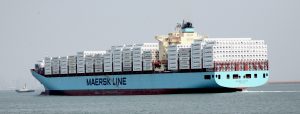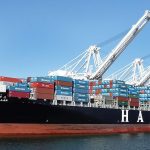There’s High Risk of More Carrier Collapses Says Drewry

Maersk Cargo Ship pic: Maersk Line
Will we see more major carriers, like Hanjin, go bankrupt soon?
According to the work of a major research company in the international shipping industry, it looks not only possible but likely.
The international shipping industry is nowhere near finished cleaning up after the bankruptcy of Hanjin Shipping, and it is at high risk of seeing more carrier failure in the near future according to Drewry Maritime Research.
Drewry has this thing called a Z-score that indexes the financial stress of carriers. And surprise, surprise, carriers are not doing well.
Drewry issued a “Red Alert” with a recent article that shares just how bad things look for carriers according to its Z-score research. Here’s a quick excerpt that explains the current situation:
During the 2008-09 industry crash Drewry initiated a Z-score freight operators’ financial stress index, which is updated in our monthly Sea & Air Shipper Insight report, to provide a quick reference to the financial fitness of selected service providers. Any reading below 1.8 indicates a higher risk of bankruptcy, which our sample of major carriers collectively have not been able to escape from since the end of 2010. To emphasise the scale of the current financial risk the sample carriers’ average Z-score rating fell to its lowest point since the series started after the second-quarter 2016 financial statements were released.
The carriers that Drewry indexes in its Z-score index are A.P. Moller-Maersk, China Cosco, CSCL (until 4Q15), CMA CGM, CSAV until 3Q14, Evergreen, Hanjin (though it’s being removed since its collapse), Hapag-Lloyd, HMM, Israel Corp (parent of Zim) until 4Q14 then switching to Zim, K Line, MOL, NOL (parent of APL) until 1Q16, NYK, OOIL (parent of OOCL), Wan Hai, and Yang Ming.
While this list does not include every carrier in the industry, MSC being the biggest notable absence, it is plenty to give a good idea of the health of international shipping’s carriers. Obviously, that health is not good.
Even Maersk, the largest carrier in the international shipping industry by capacity, is not looking strong according to Drewry’s Z-score findings.
“Based on the latest available financial reports the Z-score table shows that only two (A.P. Moller-Maersk and OOIL) of the 14 selected companies scored high enough to make it to the cautionary ‘grey zone’, with the remainder struggling in the ‘distress zone’,” Drewry says.
Maersk is looking stronger than other carriers, even making plans to acquire competing carriers, but stronger doesn’t mean strong.
Maersk isn’t in the distress zone, and I would not bet on Maersk to go bankrupt, but the “grey zone” that it is in causes potential business partners to be advised to be cautious before entering into a contract with the company.
The fact that almost all carriers reside below the “grey zone” in the “distress zone” is a scary thought.
Of course, the “distress zone” was where Hanjin resided before its collapse. For years, carriers have been in this zone of financial stress. Drewry’s research shows the situation has only gotten worse with the onset of lower and lower freight rates the industry has experienced recently while plagued with overcapacity (largely self-inflicted by the carriers and their obsession with megaships).
In previous Universal Cargo blogs, I’ve talked about the lack of transparency from carriers in the international shipping industry. Shipper, it would seem, have finally had enough.
Drewry emphasizes shippers’ demand for financial transparency from carriers in the industry since the collapse of Hanjin. Shippers need to know just how much risk there is importing and exporting their goods with various carriers. After all, that risk is high.





JV, the Z Factor is interesting, though if all of the carriers are in the gray-distress-zone as was Hanjin. Then how would we importers know which shipper was near collapse before we agreed to terms with them?
Thanks for the question, Dave. That is a great one, and a major issue for the international shipping in general right now. Carriers do not have very good transparency when it comes to their finances or even operations, like when a scheduled sailing is going to be cancelled or delayed or cargo is going to be placed on an alliance partner’s ship. The collapse of Hanjin is creating a demand from shippers for carriers to have a greater level of transparency, especially in terms of finances. Hanjin’s z-score was even worse than other carriers, but what these z-scores reveal is that many carriers are in a dangerous place financially. Many larger shippers are demanding to see financials from carriers before signing big contracts with them. The carriers make the shippers sign confidentiality agreements. Small to medium shippers, who can’t deal directly with the carriers, unfortunately do not have the same options. However, with the demand for transparency shift, big carriers should start getting used to a higher level of transparency because they’re not going to really have much of a choice.